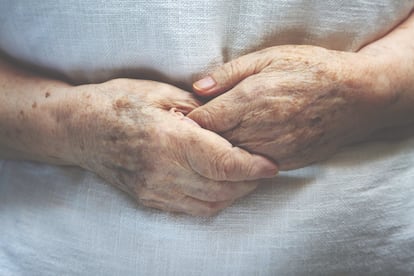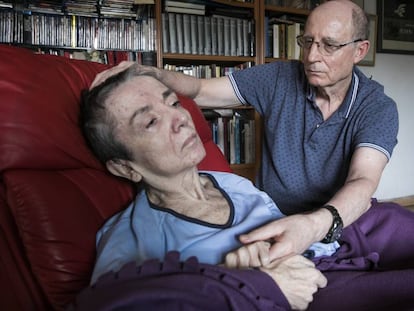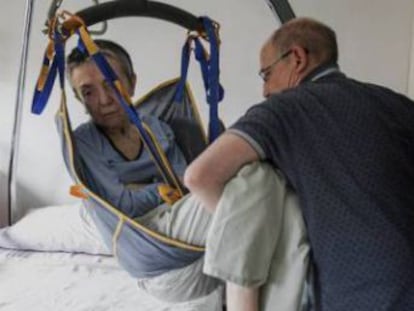A morning of white light: a doctor’s story of euthanasia
When Jesús Medina, a doctor from Spain, performed the procedure for the first time, he went home and wrote about how he felt and what he saw

Jesús Medina, a doctor working in Leganés (Spain) performed his first euthanasia on November 15, 2021. A year after Spanish law allowed euthanasia, 172 procedures have been performed. “Don’t let me down,” said the patient, an 86-year-old woman with terminal colon cancer. She wanted to die with dignity, but was powerless to act until Madrid’s regional government created a review board to evaluate each euthanasia request. When the board was in place, the terminally ill woman submitted her request only to have it rejected. She appealed the decision, and the board approved the procedure three months later. Medina returned home that evening after performing euthanasia for his first time, and wrote the following account of his experience.
I must prepare myself inside and out this Thursday morning. I had a restless night and woke up early. In the shower, I noticed my body was shaking.
I pray and share my feelings with my loved ones.
I pray again for a long time after everyone has left the house.
I go outside and I’m still shaking. I don’t want to take the car because I’m afraid I won’t be able to drive. But I take a leap of faith–I know I can drive.
We arrive at the gate. The sky is so clear and blue that it looks like gift wrapping over the city.
We’re all there–the two nurses and me. We take a few moments before going in to talk about how nervous we are. But we all firmly believe that this is a medical procedure, to be performed with love and respect for individual freedom.
There is an almost festive atmosphere at the patient’s house (like people waiting for the bride to depart the wedding reception).
All her children are there, along with many grandchildren. The most anxious person seems to be her husband.
She looks splendid. Dressed in white pajamas and a flowered bathrobe.
She is wearing makeup and perfume, and holds a bouquet of fresh flowers given to her by her granddaughters.
We discretely greet everyone with nervous anticipation.
She comforts everyone who approaches. She is poised, strong, serene, and paradoxically, seems to be full of life.
We explain the steps: first, we’ll prepare the medication in the bedroom. Then, the patient will come into the bedroom, and we’ll insert two venous access ports. At that time, any relative who wishes to be in the room can enter.
The room is organized and scrupulously neat. There is a solemn but friendly atmosphere. We want everything planned out so the procedure will go smoothly.
We can hear the family in the living room giving kisses, and expressing regrets and gratitude. There are some sobs and a few final, tight embraces.
She comes into the bedroom and lies down on the bed, completely at ease. She talks to us in a jovial tone about a few specific details and some transcendental topics.
She thanks me for all my support these past few months, and says some very nice things that I can’t remember. I tell her that it was love at first sight, that I will never forget her.
Some relatives enter the room as we insert the two intravenous lines.
The room is white, her pajamas are white, the propofol is white. White awnings filter the morning light that streams in through the window.
The sedative begins to work, but she keeps smiling. Her granddaughters tell her how much they love her, and she says goodbye, wishing happiness to all of us.
It’s half past eleven. There is a spirit of peace in the air, a spirit of dignity, reverence for life, and respect for the process of dying that I have never before experienced.
Tu suscripción se está usando en otro dispositivo
¿Quieres añadir otro usuario a tu suscripción?
Si continúas leyendo en este dispositivo, no se podrá leer en el otro.
FlechaTu suscripción se está usando en otro dispositivo y solo puedes acceder a EL PAÍS desde un dispositivo a la vez.
Si quieres compartir tu cuenta, cambia tu suscripción a la modalidad Premium, así podrás añadir otro usuario. Cada uno accederá con su propia cuenta de email, lo que os permitirá personalizar vuestra experiencia en EL PAÍS.
¿Tienes una suscripción de empresa? Accede aquí para contratar más cuentas.
En el caso de no saber quién está usando tu cuenta, te recomendamos cambiar tu contraseña aquí.
Si decides continuar compartiendo tu cuenta, este mensaje se mostrará en tu dispositivo y en el de la otra persona que está usando tu cuenta de forma indefinida, afectando a tu experiencia de lectura. Puedes consultar aquí los términos y condiciones de la suscripción digital.
More information
Últimas noticias
Most viewed
- Reinhard Genzel, Nobel laureate in physics: ‘One-minute videos will never give you the truth’
- Oona Chaplin: ‘I told James Cameron that I was living in a treehouse and starting a permaculture project with a friend’
- Pablo Escobar’s hippos: A serious environmental problem, 40 years on
- Charles Dubouloz, mountaineering star, retires at 36 with a farewell tour inspired by Walter Bonatti
- Why we lost the habit of sleeping in two segments and how that changed our sense of time










































